Sir Francis Bacon (1587 – 1657)
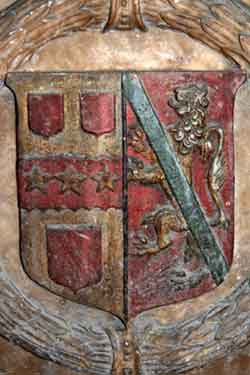 Sir Francis was the eldest of five sons and a daughter of John Bacon (d. 1618), of King's Lynn, and his wife, Elizabeth, daughter of Henry Paynell of Belaugh, Norfolk.
Sir Francis was the eldest of five sons and a daughter of John Bacon (d. 1618), of King's Lynn, and his wife, Elizabeth, daughter of Henry Paynell of Belaugh, Norfolk.
Bacon was called to the bar in 1615. He became Steward of Norwich in 1639 and Recorder in 1642. In the same year he was appointed a judge to the king's bench and knighted. After Charles I's execution, new commissions were issued to the judges, requiring them to take the oath in the name of the people instead of the king. At this time Bacon resigned and retired to Norwich with His wife Elizabeth (1595 – 1651)
He had links throughout his life to St Gregory. His eldest daughter, Barbara, was baptized there in October 1622. The family were firmly settled in the parish, paying towards the repair of the font and east window of the church, and their six sons and two daughters, all born in the 1620s, were eventually buried there, the last in 1710.
Elizabeth died soon after the family returned to Norwich she was buried at St Gregory's church on 9 October 1651, aged fifty-six. Sir Francis died on 22 August 1657, and was buried in the same place.
The Chest Monument
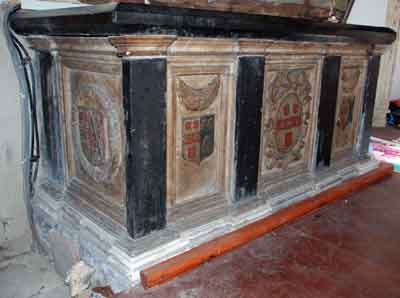 There are two elements to the monument : a box tomb and a wall monument. It is probable that originally the wall monument would have been above the tomb - this is no longer the case.
There are two elements to the monument : a box tomb and a wall monument. It is probable that originally the wall monument would have been above the tomb - this is no longer the case.
This magnificent chest tomb was commissioned by Elizabeth and Francis' eldest son (also called Francis) and originally placed in the south-east chapel of St Thomas. In keeping with the style of the time, black marble is used extensively in the tomb's construction which features the Bacon family crest (pictured on the left below).
Other segmented shields picture the Bacon coat of arms on the left and those of families associated with the Bacon's on the right e.g. the Paynell family
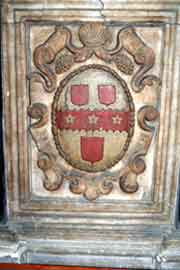
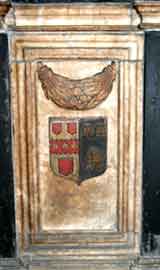
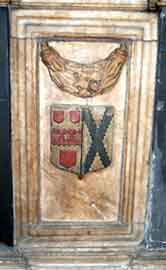
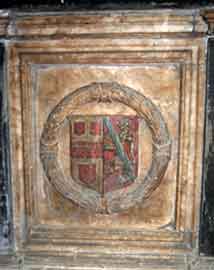
The Wall Monument
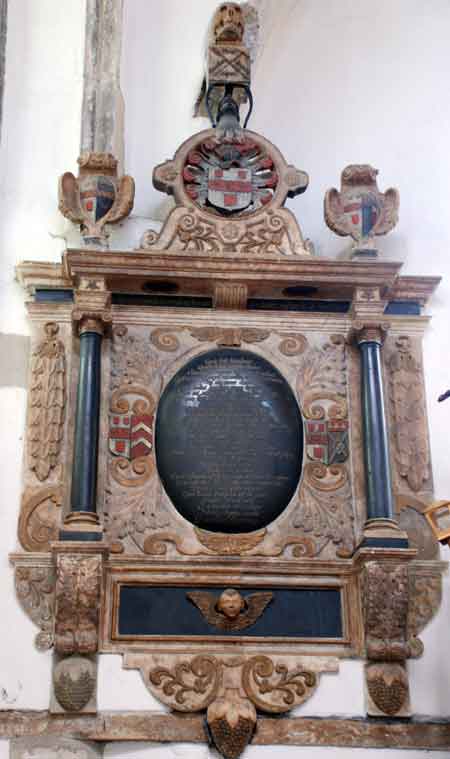 The wall monument pays eulogy in Latin to St Francis which basically says he was a worthy judge who deserves to be mourned .There are also references to his refusal to abandon his alliegance to the crown and his subsequent return to Norwich. All of these facets are illustrated by references to biblical and mythological figures:
The wall monument pays eulogy in Latin to St Francis which basically says he was a worthy judge who deserves to be mourned .There are also references to his refusal to abandon his alliegance to the crown and his subsequent return to Norwich. All of these facets are illustrated by references to biblical and mythological figures:
Niobe : A mortal woman in Greek mytholology whose fourteen children were killed by the Gods and whom is often a symbol of mourning
Solomon : Solomon was the builder of the "First Temple of the Lord" in Jerusalem.In the bible he is described as being great in wisdom, wealth, and power.
Astraea : In Greek mythology Astraea ("star-maiden") was a daughter of Zeus and Themis. She and her mother were both personifications of justice. As mankind became wicked, she was the last of the immortals to stay on earth, ascending to heaven to become the constellation Virgo. The scales of justice she carried became the nearby constellation Libra.
The final paragraph makes reference to another Francis Bacon and to St Albans. This is believed to be a reference to Francis Bacon, Viscount St Alban (1561–1626), lord chancellor, politician, and philosopher
The translation reads :
"Who comes here, may I ask, who seeks Niobe who has been turned to stone and whose tears dry up the sea? No one can run away from such tears unless they are part of the sea. Be not silent men of stony speech. Equality is indeed just when making laws. He came here burdened, wasted and weighed down. You do not know the unknown. He heard like the Etruscan soldier not wanting to bend to the law for whom is this hymn-like monument of law a mediator, a judge, a reference point, a touchstone, a Solomon here on earth impartial (if anyone is) like the judge in heaven.
At last he is at rest and lies here although he but lies in wait impervious to sand and decay who scolded the world with oratorical attacks and the select few abandoned this good discoverer for the multiple unholy gods justice unsaid on earth. The justice of the angry heavens left the earth to flee to the stars, following Astraea restored at home with holiness, the newest light of legal business.
Rather when the name of great St Albans is spoken and in blood and in name on both sides, he hears worthy Francis Bacon."
Click here for a readable view of the inscription
What the monument tells us.
The tomb depicts various symbols including a wreath surrounding shield symbolising eternal life.
 However the main examples of iconography can be seen on the wall monument these include : a skull which is a clear sign of death, very stylised olive branches - where the olives symbolise immortality, and pomegranates.
However the main examples of iconography can be seen on the wall monument these include : a skull which is a clear sign of death, very stylised olive branches - where the olives symbolise immortality, and pomegranates.
 Pomegranates could have been featured for a number of reasons:
Firstly the inscription on the monument refers to Solomon (see above) 1 Kings 7:13 -22 describes pomegranates depicted in the temple King Solomon built in Jerusalem. Secondly because it has 613 seeds which corresponds with the 613 mitzvot (commandments) Jewish tradition teaches that the pomegranate is a symbol of righteousness - symbolism which was carried into the Christian religious decoration. Finally it could represent eternal life because of its seeds which lead to fertility and abundance i.e. rebirth.
Pomegranates could have been featured for a number of reasons:
Firstly the inscription on the monument refers to Solomon (see above) 1 Kings 7:13 -22 describes pomegranates depicted in the temple King Solomon built in Jerusalem. Secondly because it has 613 seeds which corresponds with the 613 mitzvot (commandments) Jewish tradition teaches that the pomegranate is a symbol of righteousness - symbolism which was carried into the Christian religious decoration. Finally it could represent eternal life because of its seeds which lead to fertility and abundance i.e. rebirth.

